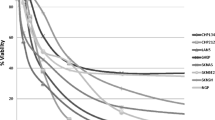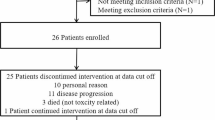Abstract
Currently, the prognosis of neuroblastoma is poor, and new therapeutic strategies are needed. This study aimed at evaluating whether the administration sequence of bevacizumab and cyclophosphamide influenced the antitumor effects in a neuroblastoma model. Bevacizumab was administered at 5 mg/kg body weight weekly, alone or combined with cyclophosphamide, to treat a neuroblastoma xenograft in nude mice, and the tumor inhibition rates were compared. The functions of tumor vessels at different time points after bevacizumab administration were detected by Hoechst 33342 labeling. The antitumor effects of cyclophosphamide, administered concomitantly with bevacizumab or when vessel function was most improved post-bevacizumab administration, were compared. The tumor inhibition rates of the neuroblastoma xenograft treated with bevacizumab, cyclophosphamide, or both were 38.1, 44.0, and 56.0%, respectively (P < 0.05). Bevacizumab reduced 64% of angiogenesis. Tumor vessel function was most improved 6 days after bevacizumab administration. The tumor inhibition rates in mice treated with cyclophosphamide, concomitantly with bevacizumab or 6 days after bevacizumab administration, were 55.9 and 66.8%, respectively (P < 0.05). Bevacizumab can reduce neuroblastoma growth and has a synergistic effect when combined with cyclophosphamide in vivo. This synergistic effect is further enhanced when cyclophosphamide is administered after bevacizumab, when tumor vessel function is most improved.






Similar content being viewed by others
References
Berthold F, Boos J, Burdach S, et al. Myeloablative megatherapy with autologous stem-cell rescue versus oral maintenance chemotherapy as consolidation treatment in patients with high-risk neuroblastoma: a randomised controlled trial. Lancet Oncol. 2005;6:649–58.
Ribatti D, Vacca A, Nico B, et al. Angiogenesis and anti-angiogenesis in neuroblastoma. Eur J Cancer. 2002;38:750–7.
Eggert A, Ikegaki N, Kwiatkowski J, et al. High-level expression of angiogenic factors is associated with advanced tumor stage in human neuroblastomas. Clin Cancer Res. 2000;6:1900–8.
Folkman J, Beckner K. Angiogenesis imaging. Acad Radiol. 2000;7(10):783–5.
Wildiers H, Guetens G, De Boeck G, et al. Effect of antivascular endothelial growth factor treatment on the intratumoral uptake of CPT-11. Br J Cancer. 2003;88(12):1979–86.
Yuan F, Chen Y, Dellian M, et al. Time-dependent vascular regression and permeability changes in established human tumor xenografts induced by an anti-vascular endothelial growth factor/vascular permeability factor antibody. Proc Natl Acad Sci USA. 1996;93(25):14765–70.
Winkler F, Kozin SV, Tong RT, et al. Kinetics of vascular normalization by BEGFR2 blockade governs brain tumor response to radiation: Role of oxygenation, angiopoietin-1, and matrix metalloproteinases. Cancer Cell. 2004;6(6):553–63.
Segerstrom L, Fuchs D, Backman U, et al. The anti-VEGF antibody bevacizumab potently reduces the growth rate of high-risk neuroblastoma xenografts. Pediatr Res. 2006;60(5):576–81.
Naito H, Ziegler MM, Tsou KC. Rational selection of adjuvant chemotherapy after cytoreduction surgery for murine neuroblastoma. Cancer Res. 1985;45:3554–60.
Klement G, Huang P, Mayer B, et al. Differences in therapeutic indexes of combination metronomic chemotherapy and an anti-VEGFR-2 antibody in multidrug resistant human breast cancer xenograft. Clin Cancer Res. 2002;8(1):221–32.
Neufeld G, Cohen T, Gengrinovitch S, et al. Vascular endothelial growth factor (VEGF) and its receptors. FASEB J. 1999;13(1):9–22.
Guo D, Jia Q, Song HY, et al. Vascular endothelial cell growth factor promotes tyrosine phosphorylation of mediators of signal transduction that contains SH2 domains. Association with endothelial cell proliferation. J Biol Chem. 1995;270(12):6729–33.
Rousseau S, Houle F, landry J, et al. p38 MAP kinase activation by vascular endothelial cell growth factor medicates actin reorganization and cell migration in human endothelial cells. Oncogene. 1997;15(18):2169–77.
Langer I, Vertongen P, Perret J, et al. Expression of vascular endothelial growth factor(VEGF) and VEGF receptor in human neuroblastoma. Med Pediatr Oncol. 2000;34:386–93.
Rossler J, Brett S, Havers W, et al. Vascular endothelial growth factor expression in human neuroblastoma: up-regulation by hypoxia. Int J Cancer. 1999;81:113–7.
Breit S, Ashman K, Wilting J, et al. The N-myc oncogene in human neuroblastoma cells: down-regulation of an angiogenesis inhibitor identified as activin A. Cancer Res. 2000;60:4596–601.
Hurwitz H, Fehrenbacher L, Novotny W, et al. Bevacizumab plus irinotecan, fluorouracil, and leucovorin for metastatic colorectal cancer. N Eng J Med. 2004;350(23):2335–42.
Yang K, Wang YJ, Chen XR, et al. Effectiveness and safety of bevacizumab for unresectable non-small-cell lung cancer: a meta-analysis. Clin Drug Investig. 2010;30(4):229–41.
Gray R, Bhattacharya S, Bowden C, et al. Independent review of E2100: a phase III trial of bevacizumab plus paclitaxel versus paclitaxel in women with metastatic breast cancer. J Clin Oncol. 2009;27(30):4966–72.
Bozec A, Sudaka A, Fischel JL, et al. Combined effects of bevacizumab with erlotinib and irradiation: a preclinical study on a head and neck cancer orthotopic model. Br J Cancer. 2008;99(1):93–9.
Tong RT, Yves BSVK, et al. Vascular normalization by vascular endothelial growth factor receptor 2 blockade induces a pressure gradient across the vasculature and improves drug penetration in tumors. Cancer Res. 2004;64:3731–6.
Koukourakis MI, Giatromanolaki A, Sivridis E, et al. Hypoxia·inducible factor(HIF1α and HIF2α), angiogenesis, and chemoradiotherapy outcome of squamous cell head and neck cancer. Int J Radiat Oncol Biol Phys. 2002;53(5):1192–202.
Mahoney BP, Raghunand N, Baggell B, et al. Tumor acidity, ion trapping and chemotherapeutics I. Acid pH affects the distribution of chemotherapeutic agents in vitro. Biochem Pharmacol. 2003;66(7):l207–1218.
Primeau AJ, Rendon A, Hedley D, et al. The distribution of the anticancer drug doxorubicin in relation to blood vessels in solid tumors. Clin Cancer Res. 2005;11:8782–8.
Virginia JY, Michael GO, Amanda S, et al. Antiangiogenic therapy decreases integrin expression in normalized tumor blood vessels. Cancer Res. 2006;66(5):2639–49.
Author information
Authors and Affiliations
Corresponding author
Rights and permissions
About this article
Cite this article
Zhen, Z., Sun, X., He, Y. et al. The sequence of drug administration influences the antitumor effects of bevacizumab and cyclophosphamide in a neuroblastoma model. Med Oncol 28 (Suppl 1), 619–625 (2011). https://doi.org/10.1007/s12032-010-9664-3
Received:
Accepted:
Published:
Issue Date:
DOI: https://doi.org/10.1007/s12032-010-9664-3




